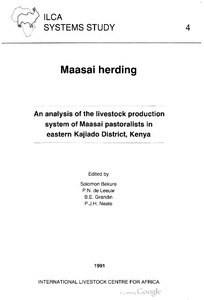Resource information
The first chapter gives a brief description of a pastoral production system, as envisaged by the study team and outlines the multi-disciplinary approach of the study, its sampling design and the data collected. Chapters 2 & 3 describe Kenya's biophysical and socio-economic environments, within which the Maasai livestock production system operates. The biophysical environment of the study site is described in detail in Chapter 4. Chapter 5 describes the social organization of the Maasai and how it affects their use of livestock and grazing resources. The division and specialisation of labour by age and sex classes are described in chapter 6. The short term productivity of Maasai cattle, sheep and goats is analysed in Chapter 7. Chapter 8 analyses how the Maasai used their livestock and how this determined the mix of species, sex and age of the livestock they kept. It also analyses the pattern of food and non-food consumption and the resulting patterns of cash income and expenditure. Chapter 9 presents an economic analysis of the short-term livestock production of the Maasai. First the short-term costs and returns of Maasai livestock production are analysed as observed during the study period. Subsequently the operation of the regional livestock market and its links with the pastoral hinterland and the final livestock markets are described and the efficiency analysed. Finally the historical terms of trade of the pastoral Maasai and how they have affected their welfare is discussed.



